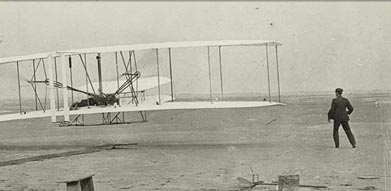Buoyant over the success of their 1902 glider, the Wright brothers were no longer content to merely add to the growing body of aeronautical knowledge; they were going to invent the airplane. Still, they recognized that much hard work lay ahead, especially the creation of a propulsion system. During the spring and summer of 1903, they were consumed with leaping that final hurdle into history.
On December 17, 1903, Wilbur and Orville Wright made four brief flights at Kitty Hawk with their first powered aircraft. The Wright brothers had invented the first successful airplane.
Unlike the solid, steam-bent wing ribs of the earlier gliders, the ribs of the 1903 Flyer were built up from two thin strips of ash with small blocks in between. The curvature of the airfoil was 1 in 20, slightly greater than on the 1902 glider.
The Wrights further refined the wings by covering the bottom surfaces with fabric. This resulted in a smoother overall wing surface, which enhanced its aerodynamic efficiency. The wooden structure once again “floated” inside fabric pockets, now sewn to the inside of the lower fabric layer. The brothers continued to apply the fabric on the bias (the direction of the weave at a 45-degree angle) to increase the stiffness of the wings.
The Wrights cleverly supported the middle of the wing struts with a fine wire, secured on both sides so the struts would not flex under flight loads. To achieve the same strength without the wire would have required thicker, heavier struts.
The Wrights’ initial confidence waned, however, as they began to confront an unsettling pattern of setbacks. Between technical problems and bad weather, they at times wondered if their self-assured intention to fly the airplane in 1903 was premature.
Because of its size and weight, the Flyer could not be hand launched like the Wright gliders. The brothers built a 60-foot launching rail from four 15-foot two-by-fours laid end to end. To take off, the airplane rode down this track on a small, wheeled dolly or “truck,” as the Wrights called it. The brothers referred to their launching track as the “Grand Junction Railroad.”
Analysis
The history of the Wright brothers and the history of the area is important to the project for me because I believe that the design needs to nod to the history. I want to create an area for people to come, enjoy, and work while also remembering the things that happened in this area. The National Aviation Heritage Area wants to conserve, interpret, develop, and promote the historic resources of the area. So, I believe it is important for me to incorporate it to my design.
https://airandspace.si.edu/exhibitions/wright-brothers/online/fly/1903/index.cfm




